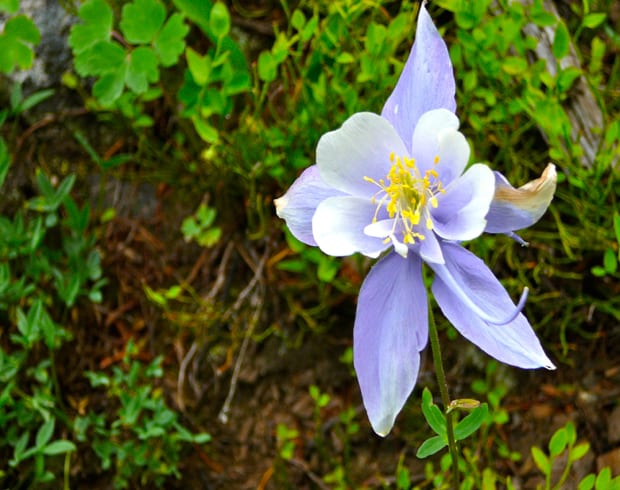Colder climates may still be shrugging off winter, but most gardeners are excited to be back to work by April. Dry summers in California and the American Southwest call for drought-tolerant plantings and water-wise practices. Butterflies signal spring’s return in the Great Lakes region and elsewhere,while flowering native trees make their presence known in the Northeast. In Texas and the Southeast, warming temperatures mean everything from herbs to vegetables to annuals can be sown from seed. Here’s what to do in your garden, by U.S. region, this April.
Rocky Mountain Gardener’s April Checklist
 Photo: Lake Irene Trail in Rocky Mountain National Park via Flickr user KrossbowPlanting is the name of the game in the April garden. Plants in all forms can be installed as soon as the soil is warm and workable. In the meantime attend to the last of the spring cleanup chores and get your lawn in shape for the coming season. Enjoy the symphony of greens that’s being played right now by all of the emerging new foliage.
Photo: Lake Irene Trail in Rocky Mountain National Park via Flickr user KrossbowPlanting is the name of the game in the April garden. Plants in all forms can be installed as soon as the soil is warm and workable. In the meantime attend to the last of the spring cleanup chores and get your lawn in shape for the coming season. Enjoy the symphony of greens that’s being played right now by all of the emerging new foliage.
Plant bare root plants. Roses, clematis and young fruit trees are commonly available for sale in our region this month, as well as asparagus, rhubarb, strawberries and grapes.
Bare-root planting is an economical option that comes with a small window of time to implement, so take advantage of the opportunity. Select plants that have not leafed out yet with a well-developed, healthy root system (not dried out or rotted). Plant them as soon as possible – if not immediately – after purchasing and keep them moist until the root system is established.
Transplant or divide crowded perennials when new growth emerges. Summer and fall bloomers like asters, hummingbird flower (Zauschneria spp), Maximillian sunflower (Helianthus maximiliana), gayfeather (Liatris spp), tall garden phlox (Phlox paniculata), coneflower (Echinacea spp) and ornamental grasses may need attention.
A plant with a dead center or a lack of blooms last year may indicate that it needs to be divided. Here’s how:
- Use a sharp spade to dig out the plant with as much of its root system as possible (6 to 12 inches beyond the drip line).
- Remove some of the soil from the root ball and pull or chop it into large sections that include both stems and roots.
- Replant the divisions – or share them with a friend – and water thoroughly.
Plant cold-tolerant annuals in containers as a colorful welcome to spring. Good flower choices include pansies, violas, English daisies, snapdragons and sweet alyssum. Prep any previously used containers by cleaning them thoroughly with a solution of one part bleach to nine parts hot water. Fill your pots with a growing medium made specifically for container gardens, one that’s lightweight and well draining yet moisture retentive.
Cut back woody perennials and subshrubs to within a few inches of the ground. These include Russian sage (Perovskia atriplicifolia), Powis Castle Sage (Artemesia), bluemist spirea (Caryopteris spp), butterfly bush (Buddleia davidii), leadplant (Amorpha canescens), rabbitbrush (Chrysothamnus nauseosus) and St. John’s wort (Hypericum spp).
Sow cool-season vegetable crops directly into the ground once the soil temperature is at least 40 degrees Fahrenheit. Plant potatoes, peas, Swiss chard, kale, turnips, carrots, spinach, radishes, onions and lettuces. Keep frost blankets and cloches handy to protect seedlings from the inevitable April snowstorms.
Get your lawn off to a good start.
- Core aerate your lawn before fertilizing it mid month. Leave the plugs on the lawn to decompose and add nutrients to the soil.
- Overseed thin lawn areas with high-quality grass seed when the soil temperature reaches 40 degrees Fahrenheit. Rake the area to be seeded to expose the soil, then scatter the seeds in a dense, single layer. Cover the seeded areas with a scant ¼ inch of compost and water thoroughly. Keep the area evenly moist until the seeds germinate.
- Note: do not use preemergent weed controls, such as corn gluten, in areas that have been newly seeded.
- Tune up your lawn mower and sharpen the blades. Sharp blades not only make your job easier (especially if you’re using a push or reel mower), but a crisply cut blade of grass is less susceptible to disease infestations than one that is torn and ragged from a blunt mower blade.
Install plant supports – such as circular cages, loop stakes and grow-through grids – to support tall, floriferous perennials once they come into bloom. Placing supports now will allow the plant to grow into and through the structure with a more natural appearance. Peonies, catmint (Nepeta spp), baby’s breath, delphiniums and tall varieties of yarrow (Achillea spp) are all good candidates for support.